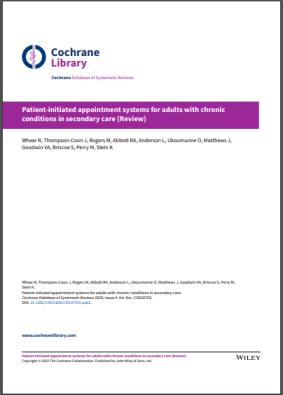In our previous intro blog we talked about a recent Cochrane systematic review on the use of patient-initiated appointment systems for managing the care of people with chronic or recurring conditions in secondary care.
This is the third of a series of blogs looking at PIAS from different perspectives. Each blog will provide a different perspective from that of a service user (patient), a clinical nurse specialist, a consultant, a service manager to that of a health service commissioner. These blogs aim to stimulate the conversation around the future of high quality and sustainable care management for those with long term, recurrent or chronic (and perhaps multiple) conditions.
The consultant perspective
So who are you and what do you do?
My name is Mark Perry, I am a consultant rheumatologist at Derriford Hospital, Plymouth and I enjoy making church and community music including singing, and playing the double bass and piano. Music helps me “switch off”, connect with people, and be creative.
What is your involvement with Patient-initiated appointment systems (PIAS)?
I first became involved in researching, implementing, evaluating, and promoting PIAS in 2002 and it’s been part of my life ever since. John Kirwan, Professor of Rheumatic Disease in Bristol and my then trainer, encouraged me to be involved with a randomised controlled trial delivering care for people with rheumatoid arthritis – it is the application of this evidence that the Direct Access system in Plymouth is based.
I moved to work as a Rheumatologist in Plymouth in 2008. Soon, I began working with the NHS Rheumatology multidisciplinary team, the National Rheumatoid Arthritis Society, and PenARC’s predecessor (PenCLAHRC) to implement and evaluate a PIAS model of care in Devon and Cornwall. In Plymouth we call the Rheumatology PIAS “Direct Access”, and in the Plymouth area about 2200 people with inflammatory arthritis and similar conditions use the service. In 2016 our service won the HSJ Value in Healthcare Award, and was runner up in the British Society of Rheumatology Best Practice Awards.

The recent systematic review of PIAS published by Cochrane suggests that a PIAS model of care may have no impact (benefit or harm) on patient anxiety, depression and quality of life, and although the evidence suggests there may be no difference in the amount of contact with health professionals it is possible that the type of contact changes. Who is involved in the contact may provide a reduction in costs associated with the PIAS system (though the evidence has yet to confirm this). Similarly adverse events may also be unaffected by use of PIAS but levels of patient (and clinician) satisfaction show variations which may reflect the type of condition a person is living with or the confidence/support they feel with their care.
How has PIAS affected you?
It took several years to convince people that the rheumatology team should change its system of care. Coordinating the change was hard work. We are now very proud of the service that we deliver – personalised, reliable, patient-centred, and largely patient-initiated care. A lot of care is delivered remotely by telephone or email. When the patient, carer or nursing team feel that face to face care is required an outpatient appointment occurs within 2 weeks. People often tell me that it is easier to come and see me than to see their GP!
I am a more relaxed doctor than I was a few years ago, and in part this is due to knowing that the people whose care I am responsible for are content with access to our service. If they are not contacting us then we are confident that they are not in need of our help. The endless apologising in clinic to patients and families for delays in appointments ground me down and, after several years of having too many patients to look after and not enough clinic appointments played a major role in my burnout several years ago. I now look forward to my Monday morning clinic, where I will help people who have invariably made the appointment within the past fortnight to seek the advice of a consultant rheumatologist. No apologies, no loss of trust, just good ol’ doctoring. Happy team, happy patients.
What do you see as the main advantages of the PIAS approach?
The PIAS approach does have advantages both to people receiving and giving healthcare.
Patients are empowered, and enabled to maximise their ability to self-care. People with one or more long-term conditions frequently lose the ability to be able to do things, and giving people the freedom to take charge of when and how they access services gives them back some control. If they have several long-term conditions, they can prioritise which is the most important now. The importance of this empowerment is often poorly recognised. A stressed NHS service frequently counts the things that are easy to count (often service/clinician centric), rather than the things that are important to the individual patient in question.

Clinicians feel role satisfaction as that they are adding value to healthcare at a time when the patient wants guidance or something doing. The wider team feels good about the care delivered – clerical, secretarial, managers and health professionals alike. At a time when much of the public sector is haemorrhaging staff, having a workforce pleased with their day’s work is a good thing.
What do you feel needs further development or consideration?
Wider implementation: Everyone involved in delivering or receiving healthcare should ask the question: Who in this group of patients (or carers for patients) can be taught about the triggers and process to access their healthcare as required? There are many people who could be taught more about self-care and then access care via a PIAS.
Helping clinicians (and patients) let go: Many healthcare professionals are “wired” to “do things” – consider how a PIAS can be marketed (to some) as “doing something to allow others to have more control”. Others need to let go of having a full room of people waiting to see them; or a large clinic list (for years hospitals have counted outpatient appointments, and therefore if you see more people you are viewed as delivering care). Do they all need to be there?
Equally, some patients have the engrained routine that they see their specialist at a certain interval. Everyone has habits about all sorts of things, and we should consider how we help the public let go.
We need robust systems for systematically identifying people for whom a PIAS is not appropriate – if it is not appropriate in one department it is unlikely to work in a second co-morbidity. Considering an individual’s patient activation, or their knowledge, skills and confidence in managing their own health and care, may help in this regard. But measures of patient activation should be considered only with care – all tests are wrong sometimes, and an individual’s ability to access care is sometimes nuanced.
Ensure appropriate clinician support as the number of “quick and easy” routine reviews reduces, and the intensity and complexity of appointments increases. Everyone needs “down time”, including down time at work. This is part of the wider workforce need to make medicine attractive and enjoyable again, rather than simply focusing on ensuring workforce resilience.
Consider access to notes – this is a challenge in many parts of NHS secondary care currently. Many NHS Hospitals have antiquated paper based clinical records. Much of our service depends on prompt access to clinical records, either when responding remotely, or within a few days in an appointment.
What would be your top tips for those considering using a PIAS approach?
Plan changes carefully and sustainably. Many people want a quick fix to the current outpatient crisis in the UK. However, this problem has taken a long time to develop, and sustainable fixes of this complex system will take time. Avoid top down implementations. Consider evolution, not revolution. Even slow progress is still progress.
Take time to build a trusting collaboration between clinicians, commissioners, and patients. Patients and clinicians who experience a poor implementation are unlikely to rush into similar or further changes. With chronic diseases there is a long wait until memories have faded and there is a further chance to try a similar approach again. Trust can take years to build, can be broken quickly, and can take even longer to repair.
Start with interested clinicians and a patient cohort with high chance of success. In Plymouth we applied the trial evidence in rheumatoid arthritis (RA) to 300 similar patients with RA, and then over several years have diversified to offer Direct Access to other related conditions including psoriatic arthritis and spondylarthropathies.
Patient education is key. Consider how to standardise the patient education package. Could this be delivered to more than one person at a time? We initially used an experienced Rheumatology Specialist Nurse, and then a trained Healthcare Assistant, and we now have a 4 minute You Tube video on the hospital website which I frequently show to people within my standard consultation. There is a long-term education of patients as they make contact with clinical concerns, so that they learn which problems we can and which we can’t help with.
Consider the engagement of the patient or their relative in their healthcare – initially you might consider patients who are likely to grasp the concept more easily. One approach to this might be to consider the Patient (or relative) Activation Measure, but remember that all tests (including PAM) are wrong sometimes. Consider contacting another health professional who might have information to help decide if a PIAS is appropriate.
Don’t confuse seeking to improve urgent care with improving self-care. PIAS can give capacity to provide urgent care, but the main thrust should be to facilitate people to provide self-care. As people become more confident in providing self-care, there is a growing capacity available to provide urgent care.
Consider capacity and how this may change during the implementation. How is safety netting going to work? Simple systems often work best in real life. What is the business continuity plan if personnel are absent? Consider PIAS as an NHS two week wait for someone with a chronic disease. How does the team ensure adequate capacity, especially initially whilst changes bed-in? In Plymouth I noticed that a proportion of patients “tested” the system soon after transferring to Direct Access.
What have you learned from you experience of PIAS and what advice would you give to someone considering starting one?
I have really enjoyed watching this story develop. It has been an honour to be involved with so many people too, over the years. It encourages me to find trainees to include in current projects – to whet their appetite in making changes to service provision. Research and implementation done together and across disciplines is more likely to be successful and be noticed by others. When patients are shown things that make sense, they vote with their feet. It is a pleasure to care for people as part of our Direct Access Service.

With many thanks to Mark for agreeing to share his experience (and his photo!).
The next blog in the ‘Perspectives on patient-initiated appointment systems’ is ‘The Service Manager‘.
Previous blogs in the series: Introduction, The Service User, The Clinical Nurse Specialist.
You can also listen to Mark discuss the Cochrane systematic review that underpins this work on this podcast.



3 Pingback